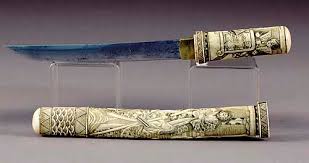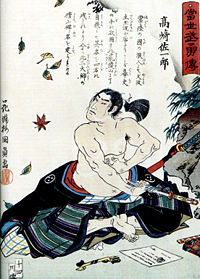 – Highlight Loc. 649-50 : The standard length of the knife for seppuku was 0.95 shaku, or about eleven and a half inches. It was wrapped in two folds of a Japanese tissue paper called sugihara paper, leaving the point exposed slightly over half an inch.
– Highlight Loc. 649-50 : The standard length of the knife for seppuku was 0.95 shaku, or about eleven and a half inches. It was wrapped in two folds of a Japanese tissue paper called sugihara paper, leaving the point exposed slightly over half an inch.
– Highlight Loc. 661-64 : As soon as the seppuku performer opened his kimono, he stretched out his right hand to seize the knife. Without allowing a moment’s delay, he cut into his abdomen from left to right. It was counted more courageous to make a slight cut upwards at the end, which was called the jumonji or crosswise cut. The exact moment of decapitation was arranged beforehand and the assistant had to know whether or not the condemned would make a crosswise or straight cut.
– Highlight Loc. 671-74 : It was considered expert not to cut the head completely off in one stroke, but to leave a portion of uncut skin at the throat, so that the head would not roll away but would hang down, concealing the face. This technique was called daki-kubi or „retaining the head,” and was taken as proof of excellent swordsmanship. The kaishaku-nin would later make the last separation at leisure, either with the same long sword or with his short knife.
– Highlight Loc. 858-60 : Confucianism teaches, „The male and female shalt not sit together even at the seventh year.” The whole relation between men and women was colored with this concept. Under the iron rule of feudalism, it was unalterable. Romance or elopement could mean death by fire or crucifixion.
 – Highlight Loc. 861-70 : In Tale of the Genji written by Lady Murasaki a thousand years ago, there were numerous stories of romance enjoyed by the Japanese of those days before the influence of Confucianism began to be felt. But, in the Edo Period, the only place where one could have free contact with women were the officially licensed gay quarters called yukaku, wherein the women were owned by the establishment or „house” and could be visited after payment of a fee. Even in such quarters, only sex—not love—was allowed. However, it sometimes did happen that men and women fell in love, even in houses of ill-fame. When such girls fell in love, they secretly sent letters protesting their devotions to their sweethearts or tried to demonstrate their feelings by avoiding carnal intercourse with other guests or even sometimes cutting off their little fingers and sending them as tokens of their love. Sometimes, when their love was thwarted at every turn, the lovers resorted to suicide to „reveal the heart.” Properly, the word was shinju-shi, but shi, meaning „death,” came to be omitted. This manner of suicide spread among the townspeople very quickly, and the latter part of the Edo Period came to be characterized by this phenomenon.
– Highlight Loc. 861-70 : In Tale of the Genji written by Lady Murasaki a thousand years ago, there were numerous stories of romance enjoyed by the Japanese of those days before the influence of Confucianism began to be felt. But, in the Edo Period, the only place where one could have free contact with women were the officially licensed gay quarters called yukaku, wherein the women were owned by the establishment or „house” and could be visited after payment of a fee. Even in such quarters, only sex—not love—was allowed. However, it sometimes did happen that men and women fell in love, even in houses of ill-fame. When such girls fell in love, they secretly sent letters protesting their devotions to their sweethearts or tried to demonstrate their feelings by avoiding carnal intercourse with other guests or even sometimes cutting off their little fingers and sending them as tokens of their love. Sometimes, when their love was thwarted at every turn, the lovers resorted to suicide to „reveal the heart.” Properly, the word was shinju-shi, but shi, meaning „death,” came to be omitted. This manner of suicide spread among the townspeople very quickly, and the latter part of the Edo Period came to be characterized by this phenomenon.
– Highlight Loc. 889-91 : Whereas seppuku could be described as the crowning culmination of Bushido and perhaps of the feudal society from which it grew, shinju arose as a form of desperate resistance and opposition to a civilization that negated humanity.
 – Highlight Loc. 966-69 : Opposition to this suppression of the freedom to love whom one pleased was expressed by shinju, where the lovers put themselves beyond the control of society. Not only was shinju a denial of feudal authority, but, when it was done by a samurai and a woman, it also meant a significant change in basic attitudes. In the Japanese code of Bushido, there is the inherent disdain of women (an influence of Confucianism) which is quite different from European chivalry.
– Highlight Loc. 966-69 : Opposition to this suppression of the freedom to love whom one pleased was expressed by shinju, where the lovers put themselves beyond the control of society. Not only was shinju a denial of feudal authority, but, when it was done by a samurai and a woman, it also meant a significant change in basic attitudes. In the Japanese code of Bushido, there is the inherent disdain of women (an influence of Confucianism) which is quite different from European chivalry.
– Highlight Loc. 1173-76 : Oddly enough, Bushido reached its zenith, in a sense, after feudalism was abolished at the start of the Meiji Restoration. Main factors contributing to this were the concentration of loyalty on the Emperor, the enactment of the conscription law (leveling the difference between samurai and chonin), and the Imperial Rescript to Military Men which helped to strengthen the code of Bushido among soldiers and sailors.
==========
04/04/2017
Jack Seward – „Hara-Kiri” 2
Lasă un comentariu »
Niciun comentariu până acum.






Lasă un comentariu